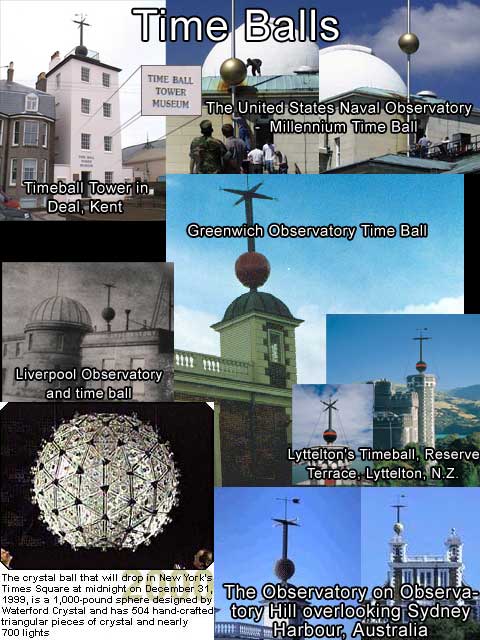Time Balls

A time ball is a large painted wooden or metal ball that drops at a predetermined time, principally to enable sailors to check their marine chronometers from their boats offshore. Accurate timekeeping is one way of enabling mariners to determine their longitude at sea.
Time ball stations set their clocks according to transit observations of the positions of the sun and stars. Originally they either had to be stationed at the observatory itself, or had to keep a very accurate clock at the station which was set manually to observatory time. Following the introduction of the electric telegraph around 1850, time balls could be located at a distance from their source of Meantime and operated remotely.The first time ball was erected at Portsmouth, England in 1829 by its inventor Robert Wauchope, a Captain in the Royal Navy. Others followed in the major ports of the United Kingdom (including Liverpool) and around the maritime world.[2] One was installed in 1833 at the Greenwich Observatory by Astronomer Royal John Pond, and the time ball has dropped at 1 p.m. every day since then.[3] Wauchope submitted his scheme to American and French ambassadors when they visited England. The US Naval Observatory was established in Washington D.C. and the first American time ball went into service in 1845. Time balls are usually dropped at 1 p.m. (although in the USA they were dropped at noon). They were raised half way about 5 minutes earlier to alert the ships, then with 2–3 minutes to go they were raised the whole way. The time was recorded when the ball began descending, not when it reached the bottom.
The Greenwich Time-ball
As the name implies, a marine time-keeper (chronometer) is designed to keep time at sea. But for navigational purposes it is necessary to know the time in the first place, and the going of the timekeeper must be checked periodically thereafter. Whatever method was used to do this, it was most unwise to move the chronometer so a pocket watch had to be used as an intermediary, or a signal be made from shore. In 1818 Captain Robert Wauchope RN proposed that time-balls should be erected. In 1833 he suggested to the Admiralty that one should be at Greenwich. In October of the same year the following notice to Mariners was issued:
The Lord Commissioners of the Admiralty hereby give notice, that a time-ball will henceforth be dropped, every day, from the top of a pole on the Eastern turret of the Royal Observatory at Greenwich, at the moment of one o’clock PM mean solar time. By observing the first instance of its downwards movement, all vessels in the adjacent reaches of the river (Thames) as well as in most of the docks, will thereby have the opportunity of regulating and rating their chronometers. The ball will be hoisted half-way up the pole, at five minutes before One o’clock, as a preparatory signal, and close up at two minutes before One.
By command of their Lordships - John Barrow
One o’clock was chosen because at noon the astronomers at the Royal Observatory might be busy finding the time. The apparatus, constructed in 1833 remains substantially unchanged today. Not only did the Greenwich time-ball - said to be the world’s first public time signal - give Greenwich time to ships in London’s river and docks but, for the first time, it made Greenwich time regularly available to those ashore who could see it. The original Greenwich time-ball of 1833 was of wood and painted leather, the present aluminium one dating to 1919. The ball is automatically raised halfway up the mast at 12.55pm, to the top at 12.58pm and drops at 1.00pm precisely, (BST in summer, GMT in winter). Until 1960 the hoisting was done by hand.
Read more: tumblong.uts.edu.au
The updated Time Ball for 2012






















